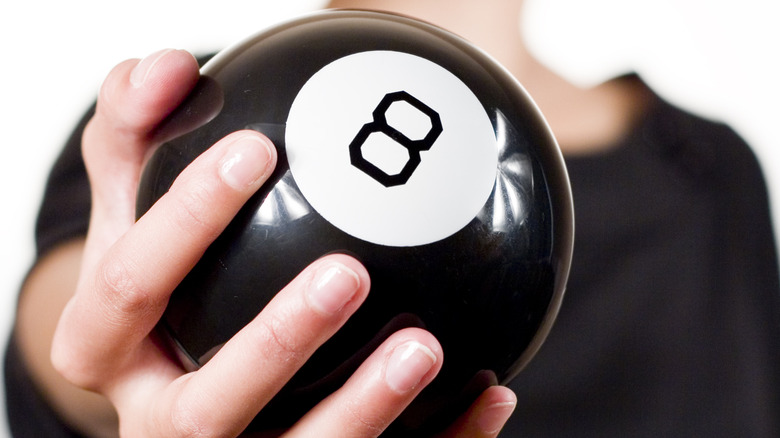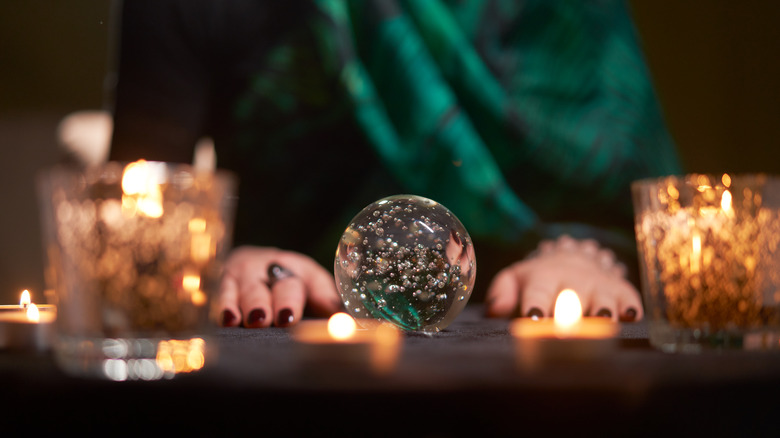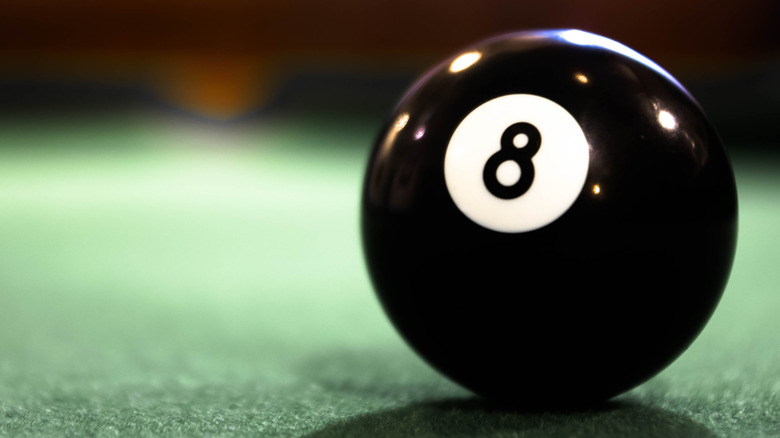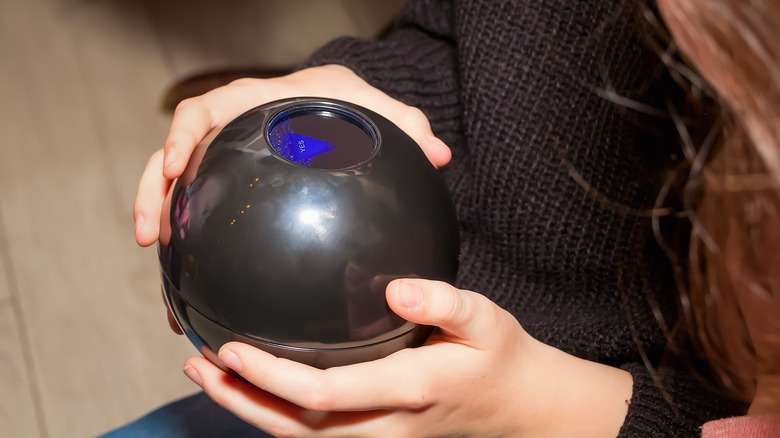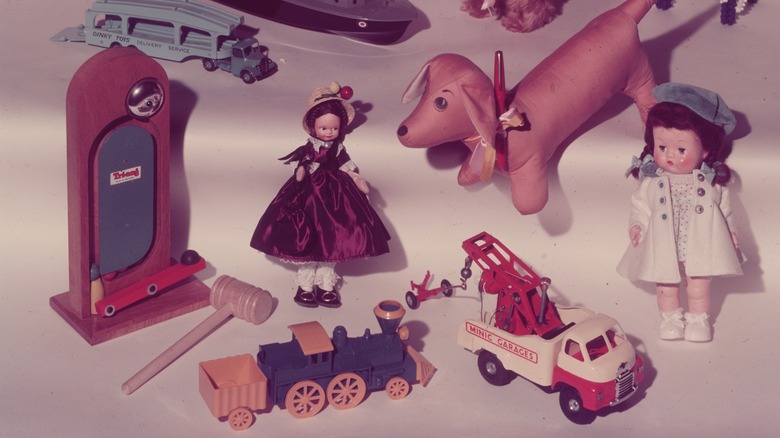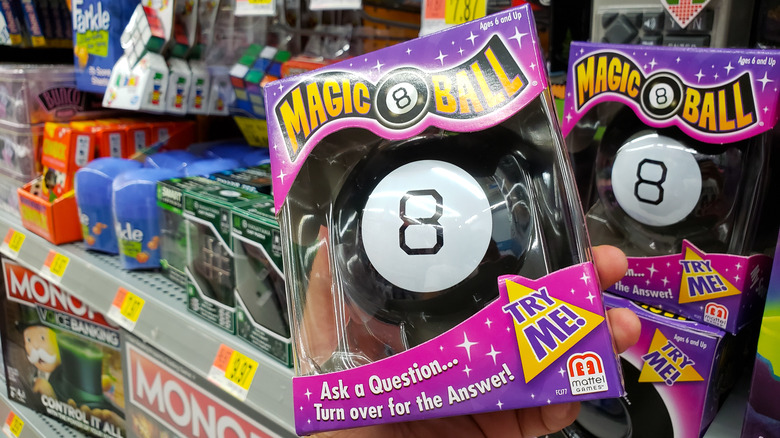The Surprising Origin Of The Magic 8 Ball
People love having their fortunes told, and there are a few classic games and toys that children and adults alike use for entertainment with just a suggestion of the supernatural to keep things interesting. Per the New York Historical Society, fortune-telling games surged in popularity in the late 1800s with a particular emphasis on activities meant to tell young women when and whom they would marry. Methods included roasting hickory nuts, observing tea leaves, lighting candles in a mirror and looking for the reflection of one's future spouse, and even melting (extremely toxic) lead in large iron spoons and dropping it into water.
Inventors and entrepreneurs have used the public's interest in fortune-telling to create all sorts of products and one of the most famous and recognizable is the Magic 8 Ball. Its official history began with the filing of United States patent number US555441A on September 23, 1944, for the "liquid-filled dice agitator."
It all started with a Psycho-Slate
The liquid-filled dice agitator that would go on to become the Magic 8 Ball was first conceptualized by a man named Alfred Carter whose mother, Mary, worked as a clairvoyant. She claimed she could communicate with the ghost of Sir Arthur Conan Doyle, among others, as reported in the 2005 book "Timeless Toys: Classic Toys and the Playmakers Who Created Them." Mary used a device she called the Psycho-Slate, a small blackboard with a lid that appeared to contain a piece of chalk that wrote on its own and answered clients' questions via spirits.
According to Core 77, Carter approached local store owner Max Levinson who brought in his brother-in-law Abe Bookman, a graduate of Ohio Mechanics Institute, to help with manufacturing and packaging, and together they formed Alabe Crafts, a combination of the two first names of Alfred and Abe. The first product iteration manufactured and packaged by Alabe Crafts was called the Syco-Seer: The Miracle Home Fortune Teller and it debuted in 1944. The original design was a cylinder with a see-through top and bottom.
The 8 ball started as a promotional item for a billiards company
Two years later, as reported by Core 77, Alabe Crafts made a smaller, cheaper version called the Syco-Slate: The Pocket Fortune Teller. Both the Syco-Seer and the Syco-Slate contained two dice with an answer on each face; the original liquid was molasses, which was vicious enough to let the dice float slowly to the top to reveal the answer to the question posed by the user. Perhaps molasses was a little too thick; by the time the Syco-Slate went into production, it was switched out for what "Timeless Toys: Classic Toys and the Playmakers Who Created Them" referred to as a liquid that looked like antifreeze and was made of alcohol and blue dye. Neither version sold particularly well, and replacing the exterior with a crystal ball didn't help.
Things took a turn for the better in 1950 when the Brunswick Billiards company out of Chicago, Illinois became interested in housing the liquid and dice interior within a casing shaped like the game of pool's iconic black and white eight-ball as a promotional item. The eight-ball version sold so well that after the Brunswick Billiards contract ran out, Alabe Crafts continued manufacturing them.
From paperweight to toy
The Magic 8 Ball was a hit, particularly among children, which meant a whole new audience and the product getting stocked at toy stores in addition to novelty stores. The original design had been marketed primarily to adults as a paperweight. Per Britannica, the fortune telling was and continues to be performed by 20-sided die containing ten positive answers, five negative ones, and five neutral ones including "Ask again later" and "Reply hazy, try again." As reported in "Timeless Toys: Classic Toys and the Playmakers Who Created Them," Ideal Toys acquired Alabe Crafts in 1971, at which point they made some improvements to the Magic 8 Ball design, including filing a patent for a new "bubble free die agitator" in 1975 that split the inner tube into two compartments separated by a funnel that traps the bubbles.
In 1987, Ideal Toys was acquired by Tyco Toys, who made few changes to the design. Eventually, toy conglomerate Mattel, home to other iconic toys like Barbie and Hot Wheels, became the owner and manufacturer of the Magic 8 Ball and remains so to this day.
Always a nominee never a winner?
Despite its status as a classic, nostalgic toy, the Magic 8 Ball was nominated several times to the National Toy Hall of Fame without receiving an induction. Fatherly investigated the Hall of Fame's processes and members, which as of late 2017 numbered 62 toys that had been added since its founding in 1998 at The Strong Museum of Play in Rochester, New York. There's an annual list of 12 nominated toys, and the Magic 8 Ball was first nominated in 2010 but was passed over a total of seven times in favor of Little People, the Super Soaker, and PEZ dispensers, to name just a few.
Inductees are selected by public nominations for a year, followed by a team of 10 curators and historians making a long list of 500 toys, followed by the 12 nominees, and finally the winners. The toys in question should be about 20 years old, "foster learning and creativity," and have innovated an area of play or toy design. In 2017, the Magic 8 Ball easily made the top 12 but was ultimately passed over for the paper airplane, Wiffle Ball, and the board game Clue. Committee members received no support from the public in favor of the Magic 8 Ball nor any statement from Mattel. One committee member theorized "I do think that even though it has the longevity we're looking for, it appeals to a very specific kind of audience that might like the idea that it's sort of magical in a way."
Magic 8 Ball: The Movie
Magic 8 Ball's many nominations to the National Toy Hall of Fame eventually led to a win in 2018 when it, along with pinball and the game of Uno, finally received its induction. Per its Hall of Fame page, millions of Magic 8 Balls have been sold over the years but its popularity continues with both adults and children; one humorist called it the "best decision-making model of the millennium."
At this point, the Magic 8 Ball is such a quintessential part of popular culture that the inevitable Magic 8 Ball motion picture is in development. According to a 2019 article from Deadline, Mattel has partnered with horror studio Blumhouse for a live-action horror movie. Jeff Wadlow, director of Blumhouse Films' "Truth or Dare" and "Fantasy Island" is slated to direct and is also writing the script with Jillian Jacobs and Chris Roach.
Per Robbie Brenner of Mattel Films, "This iconic toy has a built-in connection with fans and untapped potential for storytelling ... As fans of Mattel and their brands, we're looking forward to bringing Magic 8 Ball, one of their most celebrated toys, to life, and playing against expectations in doing so."
